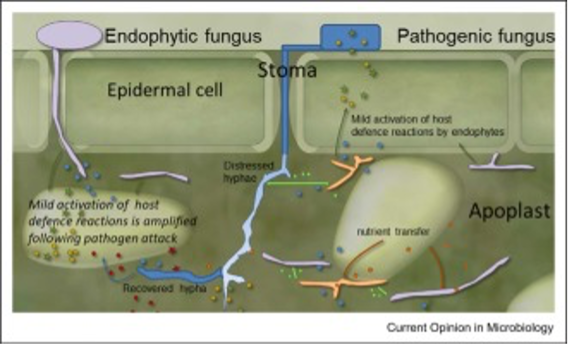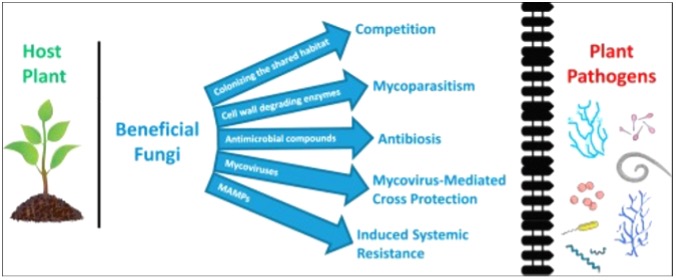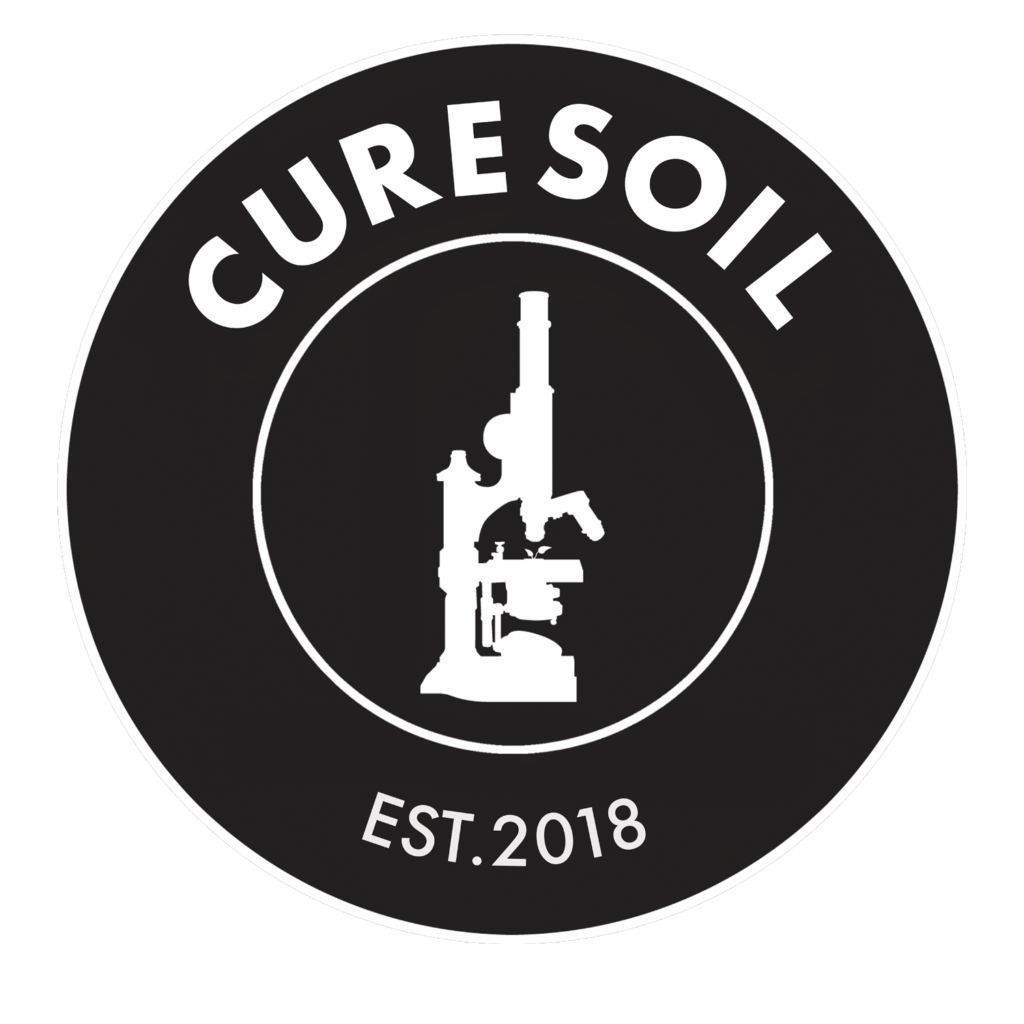SCIENCE AND DATA

Cure Soil works to implement holistic soil stewardship practices. We have found that mineral balancing in conjunction with the introduction and maintenance of a diverse colonization of soil microorganisms fast tracks a farm’s process towards becoming a vibrant self-sustaining organism in itself.
By studying the diligent work of soil ecologists, we can define the specific organism groups and their functions that lead to a soil ecosystem that is self-sustaining and devoid of the necessity for synthetic inputs. It is the symbiotic relationships that exist between plant and microbes that have endured millions of years that allow us to sustain plant production without the need for pesticides or excessive use of fertilizers.
As much as 50% of a plant’s photosynthates are excreted via the roots. These carbon-rich exudates are manufactured in the plant specifically for the individual microbes the plant wishes to culture within its rhizosphere. This is a staggering amount of energy that the plant offers to establish this symbiotic relationship. These microbes are dependent on acquiring carbon from plants to perpetuate their lifecycle. It is around carbon that this intimate relationship exists. Below we describe many of the function’s that microorganisms perform in the establishment, maintenance, and protection of their carbon source, higher vascular plants. Cure Soil compost and extract applications work to increase the quality and quantity of the microbes surrounding our plants.
Important Aspects of Soil Fertility
Nutrient cycling
The inorganic portion of all soils contains within itself a vast supply of nutrients required to support plant growth. However, these nutrients exist in forms not readily soluble in plants. It is through the presence of microorganisms living within healthy soils, and the predation they undergo that these inorganic nutrients are made available for the uptake by higher vascular plants. Thus, drastically reducing the need for fertilizer.
Soil Structure
The sand silt clay and organic matter that makes up raw soil consists of micro-aggregates and macro-aggregates. As soil structure improves, porosity increases. As porosity increases there is a drastic increase in water-holding capacity, nutrient-holding capacity and the soil’s ability to remain aerobic. Most plant diseases exist in anaerobic environments (anaerobic is defined as environments where soil levels are below 6ppm of dissolved oxygen). It is the glues excreted by bacteria and fungi that are primarily responsible for the aggregation, and the prevention of anaerobic environments in our soils. By introducing and maintaining a broad spectrum of soil microbiology we are creating an ideal foundation for plant roots & beneficial microbes to grow.
Role in Disease Prevention
Microbes are the natural defense system against pathogens and insect predation. In a thriving ecosystem both above and below ground plant tissue is coated in a living layer of microorganisms. These microbes act as both a physical and a bio-chemical barrier discouraging attack by pathogenic organisms. No demographic of the soil food web can perform these functions in and of themselves, but when the food web as a whole is present in diversity and quantity, these disease prevention mechanisms are achieved. Cure Soil practices are designed to establish and maintain these microbes throughout the entire farm organism.
The 4 Groups of Beneficial Soil Microorganisms
Quantified within Cure Soil Bio-assays
Below is an in-depth look at specific groups of microorganisms and the roles they play in maintaining the major aspects of soil fertility. The diligent work of Dr. Elaine Ingham over the past 40 years has given those of us in pursuit of healing our soils a valuable tool to measure the quality and quantity of microbiology present in our soils and our compost. It is with this education that we at Cure Soil use to make compost and bolster soil ecology.
Bacteria- (135-1,500 ug/g)
Their role in nutrient cycling predation of bacteria is consumed mainly by protozoa, bacterial-feeding nematodes, earthworms, and possibly micro-arthropods. Other bacteria and fungi may then use these materials as food or condense them into structurally more complex organic forms. The carbon-nitrogen ratio of bacteria is in the range of 5:1–10:1. Their main predator protozoa has a C:N of appx 30:1. This means that for protozoa their bacterial diet is rich in nutrients that end up being excreted as plant-available nutrients. It is this fundamental predator-prey interaction that allows farmers to drastically reduce their fertilizer inputs when achieving a healthy soil food web within their farm organism.
Soil Structure Role
Bacteria exude alkaline glues that hold sand, silt, clay, and organic matter together, forming microaggregates. These enzymes decompose organic matter and pull mineral nutrients from sand, silt, clay and organic matter. The creation of this aggregation via bacterial glues and soil particles creates pathways for oxygen to permeate the soil, thus maintaining aerobic conditions necessary for healthy plant roots to thrive.
Role in Disease Prevention
Plants excrete specific exudates targeted at encouraging specific species of bacteria. These bacteria proliferate within the rhizosphere and not only initiate nutrient cycling but also serve as physical and bio-chemical lines of defense between the plant and pathogens.
Fungi (135-1,500 ug/g)
Role in Nutrient Cycling
Beneficial saprophytic fungi possess a wide array of enzymes capable of solubilizing the mineral fraction of soil. These nutrients remain stored in their biomass until consumed by higher trophic levels. Micro-arthropods and fungal-feeding nematodes feed on them.
Saprotrophic fungi are key regulators of nutrient cycling in terrestrial ecosystems. They are the primary agents of plant litter decomposition and their hyphal networks, which grow throughout the soil–litter interface, represent highly dynamic channels through which nutrients are readily distributed. By ingesting hyphae and dispersing spores, soil invertebrates, including Arthropoda, Oligochaetae, and Nematoda, influence fungal-mediated nutrient distribution within the soil. Fungal physiological responses to grazing include changes to hydrolytic enzyme production and respiration rates (Crowther et al., 2012).
Mycorrhizal fungi improve nutrient uptake for plants, in part, by exploring the soil more efficiently than plant roots. Mycorrhizal fungal hyphae occupy large volumes of soil, extending far beyond the nutrient depletion zone that develops around roots (Simard et al., 2002).
Soil Structure
Fungi play a significant role in the macro-aggregation of soil particles. Of the many attributes beneficial fungi play within soil ecology, their ability to form complex lattices of hyphal networks within the soil ensures that aerobic conditions are maintained throughout the rhizosphere and further subterranean levels.
Saprophytic fungi were found to be involved in aggregation processes due to their filamentous growth and ability to physically move and stick particles/aggregates, as well as by hyphal water repellence and production of exudates, acting as binding agents (Lehmann and Rillig, 2015). Among fungi, arbuscular mycorrhizal fungi (AMF) strongly contributed to the formation and stabilization of aggregates by the development of an extra-radical mycelium and the release of glomalin, a binding agent glycoprotein (Wright and Anderson, 2000; Jastrow et al., 2007; Rillig et al., 2015; Lehmann et al., 2017).
Disease Prevention
Multiple mechanisms exist by which beneficial fungi protect plants from pathogenic fungi. Physical and biochemical barriers are utilized to defend plants from attack. Fungal hyphae are composed of chitin cell walls. Much like crab shells, these fungal cells are brittle and fracture from soil disturbances such as tillage. To ensure the perpetuation of these vital members of the soil ecosystem, conservation practices along with consistent applications of fungal-rich materials (i.e., fungal-rich compost) should be incorporated into annual farm plans. Beneficial fungi may be free living in soil, on the surface of plant roots and leaves, or in the case of endophytic fungi, may live within the plant itself.
The enigmatic endophytic fungi are beginning to reveal their secrets. Like pathogens, they can manipulate the host for their own benefit to create their own optimal habitat. Some endophytic manipulations induce resistance or otherwise outcompete pathogens and can thus be exploited for biological control. Like pathogens and other symbionts, endophytes produce effector proteins and other molecules, ranging from specialized metabolites, phytohormones, and microRNAs, to manipulate their hosts and other microorganisms they meet.


Protozoa
- Amoeba and flagellates Beneficial organisms 25,000-50,000 #/gram of soil
- Ciliates no more than 25,000 #/gram of soil
The free-living protozoa of litter and soils belong to two phyla, the Sarcomastigophora and the Ciliophora. We divide protozoa into 3 basic categories within the bio-assays. Amoeba and flagellates are commonly found in aerobic environments and serve a beneficial role within the soil ecosystem. Ciliates on the other hand are common in anaerobic environments and have deleterious effects on soil structure and nutrient cycling.
Role in Nutrient Cycling
Protozoa are single-celled microbes, which reproduce by binary fission. A reproductive cycle can be as short as 8 hours. In less-than-optimal conditions, reproduction will take much longer. Protozoa eat bacteria and release excess soluble nutrients into the soil solution. Classic predator-prey cycles can be demonstrated with bacteria and protozoa. As bacteria begin to exponentially increase, protozoa will begin to reproduce as well, given the increase in their prey group. Eventually, protozoan predation will outstrip bacterial reproduction rates, resulting in diminishing bacterial biomass. As bacterial numbers fall below the level where the protozoan population can be maintained, protozoa will typically encyst. As protozoan numbers reach a minimum level, bacterial numbers will begin to increase again as predation by protozoa no longer impacts the bacterial numbers. The cycle will repeat until, given a long enough time, a stable equilibrium of bacterial and protozoan populations will occur.
Reducing disturbance is, therefore, an important factor in being able to predict the amount of nutrient cycling that will provide plants with needed soluble nutrients. Protozoa have a C:N around 30:1. Thus most bacteria contain more nutrients of all types than the protozoa needs and the protozoan will release these nutrients in a soluble, inorganic form. Predation Protozoa are eaten by micro and macro-arthropods, earthworms, and possibly bacterial-feeding nematodes or other large predators in the terrestrial system. Protozoa have preferred prey items, and predators of protozoa show preferences as well. The importance of these preferences have not been determined.
Soil Structure
We often consider the primary function of protozoa to be nutrient cycling, however, research has shown that protozoa play a role in root architecture, thus indirectly affecting soil structure via root morphology. Microfauna interactions with mycorrhiza provide a good model system to study the interplay of plants with multiple microbial root associations. Bacteria–protozoa interactions benefit from increased root exudation and favor the development of an extensive and highly branched root system. Hyphal extensions of mycorrhizal root systems, by contrast, are commonly formed at the expense of root structures (Jonsson et al., 2001; Lerat et al., 2003). The response of plants to these conflicting demands was investigated in two experiments where nonmycorrhizal and ectomycorrhizal Norway spruce seedlings (Picea abies) were inoculated with a bacterial soil inoculum or bacterial inoculum plus protozoa (Jentschke et al., 1995; Bonkowski et al., 2001b)
In both experiments, the presence of protozoa caused the development of a highly branched root system with longer and thinner roots (Fig. 5), whereas mycorrhiza had opposite effects on root architecture (Jentschke et al., 1995; Bonkowski et al., 2001b).
Disease Prevention
Protozoa preferentially graze on different species of bacteria, and some evidence has been found to show that protists prefer pathogenic over beneficial bacteria. In agronomic soils where additions of soluble fertilizers are applied, bacterial populations will grow exponentially if unchecked. The elevated levels of respiration caused by these bacterial colonies can consume so much available oxygen from the soil that dissolved O2 levels may drop below 6 ppm, thus inducing anaerobic regions and depriving plant roots of oxygen needed to carry on their necessary metabolic processes. By controlling these bacterial populations protozoa maintain plant vigor. As with us humans, the best medicine is a balanced diet. When we have all the nutrition our body requires, we can support our internal immune systems and fight off disease naturally. When the minimum levels of protozoa (25,000#/g of soil) are maintained, we can be assured that effective nutrient cycling is taking place, thus helping the plant’s internal immune system to function properly). The broad-spectrum toxins responsible for plant protection also inhibit predation by protozoa and nematodes, the main consumers of bacteria in soil. Therefore, predation pressure may favor biocontrol bacteria and contribute to plant health (Müller, et. al. 2013).

Nematodes
Within our bio-assays, we classify nematodes based on their diet. We can define what category these nematodes fall into based on their morphology, visible under the microscope at 400x magnification.
Nematode Categories:
- Bacterial feeders (100 #/gram of soil)
- Fungal feeding (10 #/gram of soil)
- Predatory (1 #/gram of soil)
- Detrimental nematodes are root-feeding nematodes(0 #/g soil)
Nematodes are the most numerous multicellular animals on Earth and no other group of animals, with the exception of insects, has had such an impact on civilization (Maggenti,1981). Nematodes are small, slender worms, typically about 5 to 100 µm thick, and 0.1 to 2.5 mm long. Most nematode species have male and female individuals; a few species are hermaphroditic (self-fertilizing).
Nutrient Cycling
Classic predator-prey cycles can be demonstrated with nematodes which consume bacteria or fungi. Nematodes have a thick cuticle made of collagen surrounding their body that is high in carbon. Once the nematode clears any cytoplasm or bacterial soup that it consumed, nematodes have a C:N ratio close to 100:1. Thus either the cytoplasm or bacteria that nematodes consume contain much higher levels of nutrients than the nematode requires. Hence, nematodes release nutrients in a soluble, inorganic form that plants can take up. Predation microand macro-arthropods with chewing mouth parts will consume nematodes. Nematodes are also consumed by earthworms.
Soil nematodes play a crucial role in the terrestrial N cycle by accelerating the release of ammonium from microorganisms (bacteria and fungi). Free-living nematodes that feed on bacteria and fungi contribute as much as 27% of the readily available nitrogen in the soil (Ekschmitt et, al., 1999).
Bacterivorous, frugivorous, and omnivorous nematodes feed on microbes and excrete nutrients in excess of their metabolic need, primarily as plant-available organic and inorganic forms such as amino acids, NH4+, and PO4−3 increasing plant uptake, in a similar way as in ‘microbial loop’ mechanism. The abundance and activity of these microbivorous nematodes may, in turn, also be regulated by predatory nematodes and other fauna, further modulating nutrient availability(Wardle, et al., 1993).
Role in Soil Structure
Norton and Niblack (1991) outlined several physical and chemical properties in the environment that impact nematodes directly. These included topographic features such as elevation and slope, and the soil environment, such as moisture and rainfall, temperature, aeration, texture, pH, and organic matter.
Nematodes do not have the same capacity to create porosity within the soil matrix that earthworms might. Although capable of having a beneficial role in soil aggregation we wish to convey how nematodes are victims to soil compaction and suffer from a lack of mobility. Nematode abundance was mainly governed by habitat constraints, which was reflected in significant correlations with soil moisture and with porosity (Schülter, Et. al., 2022). Some tilled soils with weak aggregates contain particles of such shapes and sizes that they readily compact to a system with few interconnecting pores of a size through which nematodes can pass (Jones, 1969).
Disease Prevention
The goal of agricultural nematologists is usually considered to be the prevention of harmful nematode populations from reaching levels that cause noticeable yield losses in field crops. The challenge has become finding methods to develop and maintain those systems that build up beneficial nematode populations while simultaneously suppressing plant-parasitic nematodes and associated plant pathogens.
Summary
Our results strongly suggest that sustainable agriculture will benefit from using a range of biological control mechanisms when controlling root-feeding nematodes, rather than relying on single control agents. Our suggestion also implies that conserving soil biodiversity is crucial in order to enhance the reliability of biological crop protection against soil-borne pests and diseases (Piskiewicz, 2008).
The multitude of organisms with apparently similar functions, but differing in their adaptations, provides additive contributions to specific services, for example, mineralization or regulation. As an example (Fig. 2), a diverse assemblage of rhabditid nematodes, adapted to cooler temperature conditions, provides complementary input to the service of N-mineralization in the spring while, in the summer, the complementary service is provided by cephalopod nematodes adapted to warmer conditions (Ferris et. al).
Our goal at Cure Soil is to culture and apply the widest array of organisms possible. It is within this diversity that we find resilience.


